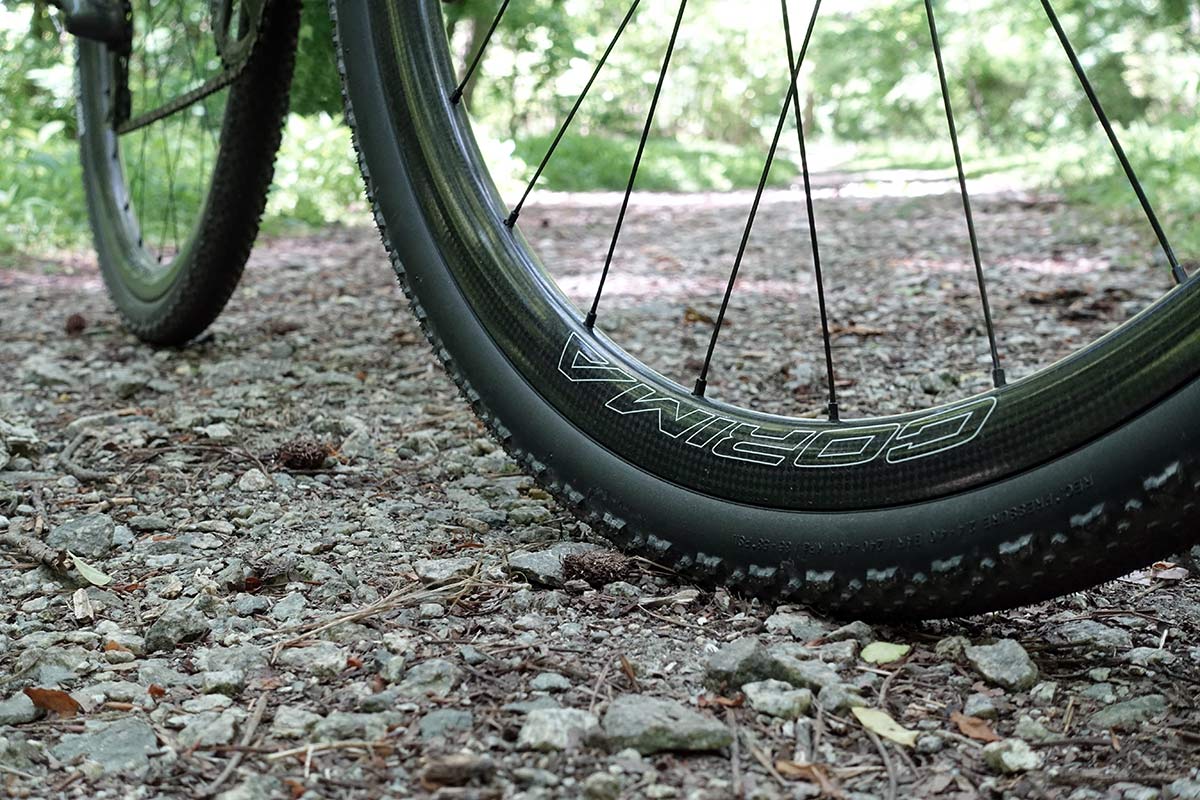In April, Corima launched their first ever Tubeless Ready rims and wheels, offering a traditional bead hook and rim tape design. Now, they’ve launched their first ever gravel wheelset, and it’s using a hookless design for wider tires and lower pressures.
The new Corima Gravel 30.5 deliver their unique foam-core carbon rim construction mated to DT Swiss 240 hubs. They’re lightweight, yet surprisingly stiff and capable. Here’s the details…
Corima Gravel 30.5 wheels specs & weights
The number 30.5 may lead you to think they’re 30.5mm wide internally, so let’s go ahead and dispel that myth. They’re 30.5mm tall. We’ll get to the widths in a sec.
They’re built with 24 black stainless steel CX-Ray bladed spokes front and rear, are disc brake only and use DT Swiss 240 Centerlock hubs with the new EXP freehub internals (but not the new, lighter 240 hubshells…yet). Spoke nipples are external, making them easy to true. They’re sold with 12×100 and 12×142 thru axles only.
Corima’s carbon rims use a foam core, along with a torsion bar (not shown) that both stiffens the rims and helps absorb vibration. The official specs are 30.5mm tall, 28mm external and 22mm internal. Claimed weight is 1,550g.
We measured our test rims at 28mm external and about 22.5mm internal.
They come pre-taped with valve stems installed and weighed in at 752g front and 835g rear. That totals 1,587g. Claimed weight is 725g and 825g, respectively, without the tape and valves.
Corima Gravel rim design…why hookless?
Corima calls their hookless rim design TSS, for Tubeless Straight Side. It’s reinforced to provide additional impact protection. The 22mm width allows for tires from 28mm to 60mm wide, with a max air pressure of 72.5psi (5bar).
The bead shelf makes for easy tubeless setup, and the 700×40 Goodyear Connector tires they sent with the wheels popped into place easily…and loudly!
Corima’s tubeless rims also use an internal venting channel, with a small silicone-plug-covered hole one spoke hole over from the valve stem to release any air pressure that leaks into the rim cavity.
OK, so why hookless?
Because they’re designed specifically for the lower pressures and wider tubeless-ready gravel tires. This gives the tires nice round profile (see photo above), and the thicker tops of the rim walls are less likely to snake bite your tire.
But, it does mean they’re only recommending tubeless-ready tires that follow the ETRTO guidelines for bead diameters. They’ll have an approved tire list on their website soon, and continue to test more tires in house to grow that list. But, for you conspiracy theorists out there, hookless rims are easier to manufacture, so of course that’s the only reason they’re doing it. But not really.
Corima Gravel wheels ride review
Corima makes noise about their custom resins and 3K carbon used on these rims, all of which are handmade in their own factory in France. Between that and the foam core and torsion box (basically a beam running across the rim’s inside, creating a strut from side to side), they make a really stiff rim. Yet somehow also not uncomfortable.
Stiffness can be subjective, but it’s easy to test. I mounted these with 40mm wide tires to my T-Lab cyclocross bike, which was designed with 700×35 cyclocross tires in mind. But, these fit, with about 4-5mm clearance per side. If the wheels were going to flex, I’d hear the tires rub the chainstays.
Whether cornering hard and fast on singletrack or laying down the power on a climb or sprint, standing or seated, they never rubbed.
And it wasn’t just the sound, but the feel. They felt stiff. Straight. Like they were tracking exactly where they should. Given that they’re using 3rd party spokes and hubs as opposed to a complete Corima-designed system, it makes the rim all that much more impressive.
I ran about 40psi in the tires, which is admittedly a compromise between choosing firm or compliant. It was low enough to still smack the rim on a couple of big roots, but mostly support me over them. It was high enough to lose some of the comfort benefits bigger tires offer, so I could see what the rims and wheels were really doing.
Even with a not-ideal-for-anything air pressure setting, the wheels worked great. I hit a few roots hard, but there’s no sign of impact. I covered plenty of ground on the pavement, and they never felt sluggish. On the mixed surface roads and trails, and even mountain bike singletrack, they performed quite well, too.
My hunch is they’d perform even better with the tire pressure adapted to the particular circumstances rather than the one-psi-fits-all approach I used during testing.
It’s easy to do an eye roll when a brand that’s been focused exclusively on pro-level aero road wheels suddenly jumps into the category du jour, but it seems like they’ve got it right. If you like your wheels laterally stiff but still light, the Corima Gravel 30.5 wheels are worth a look.













